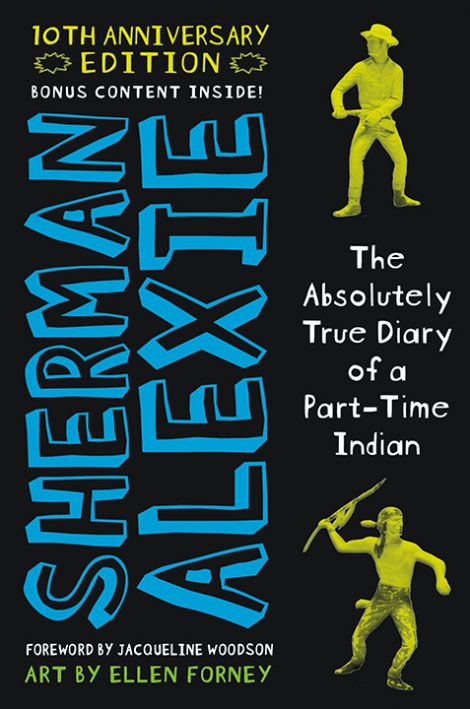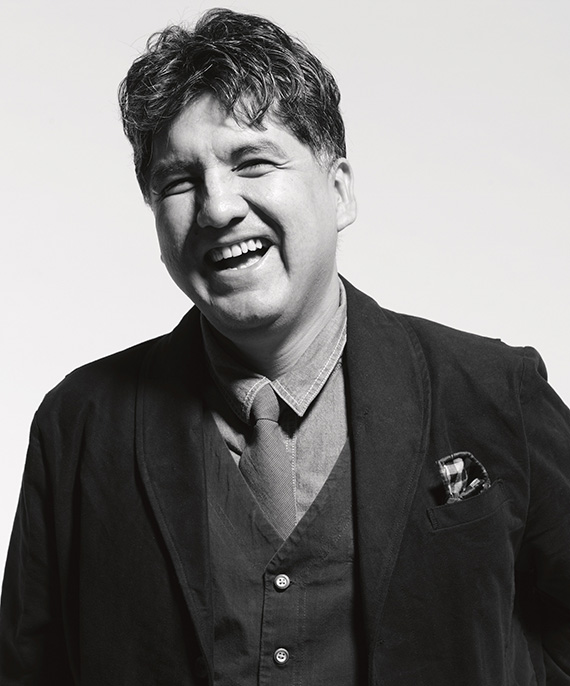
THE ABSOLUTELY TRUE DIARY OF A PART-TIME INDIAN 10th ANNIVERSARY EDITION
The 10th anniversary edition of Sherman Alexie’s National Book Award-winning and #1 New York Times bestselling novel—bonus content included!
Sherman Alexie, in his first book for young adults, tells the story of Junior, a budding cartoonist growing up on the Spokane Indian Reservation. Determined to take his future into his own hands, Junior leaves his troubled school on the reservation to attend an all-white farm town high school where the only other Indian is the school mascot.
Heartbreaking, funny, beautifully written, semi-autobiographical, and coupled with poignant drawings that reflect the character’s art,
The 10th anniversary edition of Sherman Alexie’s National Book Award-winning and #1 New York Times bestselling novel—bonus content included!
Sherman Alexie, in his first book for young adults, tells the story of Junior, a budding cartoonist growing up on the Spokane Indian Reservation. Determined to take his future into his own hands, Junior leaves his troubled school on the reservation to attend an all-white farm town high school where the only other Indian is the school mascot.
Heartbreaking, funny, beautifully written, semi-autobiographical, and coupled with poignant drawings that reflect the character’s art, The Absolutely True Diary of a Part-Time Indian will continue to make a lasting impression for many years to come. Bonus content to include an introduction from National Book Award winner and New York Times bestselling author Jacqueline Woodson, a new author’s note, an excerpt of a sequel from the character Rowdy’s point of view, and more!
- Little, Brown Books for Young Readers
- Paperback
- October 2017
- 320 Pages
- 9780316504041
About Sherman Alexie
 An award-winning author, poet, and filmmaker, Sherman Alexie was named one of Granta‘s Best Young American Novelists and has been lauded by The Boston Globe as “an important voice in American literature.” One of the most well known and beloved literary writers of his generation, his works of fiction, including Thunder Boy Jr., The Absolutely True Diary of a Part-Time Indian, Reservation Blues and short story collections Ten Little Indians and The Lone Ranger and Tonto Fistfight in Heaven, have received numerous awards and citations. He lives in Seattle.
An award-winning author, poet, and filmmaker, Sherman Alexie was named one of Granta‘s Best Young American Novelists and has been lauded by The Boston Globe as “an important voice in American literature.” One of the most well known and beloved literary writers of his generation, his works of fiction, including Thunder Boy Jr., The Absolutely True Diary of a Part-Time Indian, Reservation Blues and short story collections Ten Little Indians and The Lone Ranger and Tonto Fistfight in Heaven, have received numerous awards and citations. He lives in Seattle.
Praise
“Excellent in every way.”—Neil Gaiman
“So original…I laughed consistently from beginning to end.”—Amy Sedaris, actress, comedian and author of I Like You: Hospitality Under the Influence
“Alexie nimbly blends sharp wit with unapologetic emotion in his first foray into young adult literature.”—Kirkus Reviews (starred review)
Discussion Questions
1. Humor is a huge part of the book. How does Junior use humor to navigate his life? Why is humor important to the readers of this book?
2. When Junior is in Reardan (the white town), he is “half Indian,” and when he is in Wellpinit (his reservation), he is “half white.” Why does he feel somewhat alienated in both locations? Do you ever feel split between two roles or identities?
3. How do Junior’s cartoons show his understanding of the ways that racism has deeply affected his and his family’s lives?
4. Both Junior and his sister Mary see themselves living beyond the reservation, but Mary’s dream of writing romance novels fades away. How does Mary’s journey influence Junior? How are Mary and Junior similar?
5. Junior describes his reservation as “located approximately one million miles north of Important and two billion miles west of Happy.” Yet when he and Rowdy look down from almost the top of an immense pine, he says, “We could see our entire world. And our entire world, at that moment, was green and golden and perfect.” How does he have two such striking views? What does it say about his feelings towards his home and the people in it?
6. Why is Junior’s friendship with Rowdy so important? How does it compare to the relationships he forms when he is in Reardan?
7. Junior’s parents, Rowdy’s father, and others in their community are addicted to alcohol, and Junior’s white “friend with potential,” Penelope, has bulimia. “There are all kinds of addicts, I guess,” he says. “We all have pain. And we all look for ways to make the pain go away.” How does Junior’s understanding of addiction transcend ethnicity and class?
8. The first person, unfiltered narrative appeals to a variety of readers. How does Junior use language to lead readers, whose lives may be very different from his own, to the kind of understanding that they will not get from young adult fiction whose writers do not have this kind of firsthand experience?
9. This book often makes its way to the top of “Banned Books” lists for frequently being contested in schools and libraries. What parts do you think could be considered controversial? Do you agree?
10. Why does this book have such an impact on readers? What has caused it to be a bestselling novel for so long? Why does it resonate with so many people?
